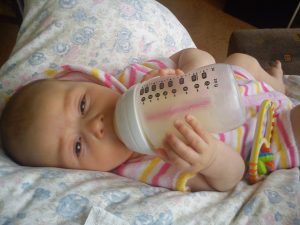Table of Contents
Overview
Too much air and wind in your baby’s stomachs may cause a lot of fussiness and discomfort, and we would not want that. That is why, when you have chosen to bottle-feed your little ones, you must select the right bottle for your baby. The most common adverse effect your babies’ might experience with the wrong bottle is indigestion and colic. We all know how colic can be stressful for both mom and baby, but once you have found the suitable bottles or came up with a good solution, it can indeed be an easy problem to address.
Nowadays, many baby bottles have already been ergonomically and smartly designed to be air-free and reduce colic in your babies. So, if you want to read more about air-free baby bottles and other necessary information, then read on.
What baby bottles are best for wind?
Anti-colic baby bottles are technically the best ones for wind. When bottle-feeding your little ones, there is a tendency where they swallow air, eventually filling their tiny stomachs with gas. Some babies would not mind, but most of them are very sensitive and will feel uncomfortable because of it. No parent would want their babies to feel fussy and uncomfortable, so we will always do our best to know what kind of bottles are best for wind.
According to doctors and lactation experts, too much wind in the baby’s stomach causes gas and will lead to colic. It is no secret that a colicky baby can be very saddening and frustrating at the same time. Fortunately, many manufacturers have already created ways to reduce gas during feeding, and that is through creating these awesome baby bottles that are best for wind.
If you have noticed a gassy baby during the start of your bottle-feeding, we will help you choose the best bottles to reduce the amount of wind that goes to your babies’ stomachs. Here are the factors that you might want to look at when selecting the best baby bottles for wind:
Material of the bottle
Typically, the most common material that you see among baby bottles are glass, plastic, and silicone. Baby bottles made out of silicone are considered the best since they are soft and tend to mimic the mother’s breasts feel. They are also easily cleaned and sterilized and are very lightweight as well. The most common brand of silicone bottles is the Comotomo bottles.
Glass baby bottles are the oldest material out there are known to be very durable and very easy to clean. However, the glass ones tend to be heavy, and your baby might have a hard time holding them, resulting in continuous feeding. Glass baby bottles also tend to be quite expensive compared to the silicone and plastic ones.
Lastly, plastic baby bottles are the most popular nowadays since they are relatively cheap and quickly produced. A downside of plastic baby bottles is that they wear out pretty quickly, and if they are not shaped right or paired with the correct nipples, they might cause colic resulting in fussy babies.
Nipple or teat material and design
When it comes to finding the best baby bottle for wind, you must look at the nipple or teat as well. The recommended material to prevent wind is silicone since they tend to be more natural and feel more natural. The shape and design of the nipple will also matter, and the most common and recommended ones are the dome-shaped nipples, which are very common but does the job very well. Another nipple shape to prevent colic is the orthodontic one. The orthodontic nipples are designed to mimic natural sucking and allow the mouth and tongue of your baby to move naturally while feeding.
Shape matters
The shape of the bottle is also quite important since they do not only need to be held by your little ones’ tiny hands, but they should also be shaped to prevent wind. The most recommended shape to prevent wind is the angled-neck bottles. This shape is designed to avoid air from getting into the baby bottle while feeding, therefore avoiding too much air in your baby’s stomach as well. The angled shape of the bottle will aid in retaining the milk in the nipple, thus stopping air from getting in. Most pediatricians also recommend this shape.
Vent or valve system
Anti-colic or air-free baby bottles work with a vent or valve system to effectively prevent air from mixing into your baby’s milk. The vent system is displayed similar to a straw that runs down from the nipple towards the bottom of the bottle. Valve systems, on the other hand, are typically located at the bottom of the bottle. Baby bottles with valve systems are believed to work better by ensuring that there is no air trapped inside the bottle because of the valve’s pressure.
How to stop the air in a baby’s bottle
Here are some of the easy yet effective ways to stop the air in baby bottles:
Prepare the milk in advance.
Preparing the formula or milk in advance and a separate container, like a cup, reduces the chances of forming air bubbles. If you prepare the milk right inside the bottle, air can accumulate and can be swallowed by your baby while feeding.
Avoid pouring the milk too far from the bottle.
After you have prepared the milk, the method of transferring it from the cup to the bottle will also matter. Avoid pouring the milk too far from the bottle; instead, get the mug or cup as close to the bottle’s lid as possible and pour slowly to avoid forming bubbles.
Stir instead of shake
During instances where you might need to prepare the milk directly inside the bottle, always remember to avoid shaking it. You can thoroughly mix or dissolve any powder through stirring. Vigorously shaking or handling the baby bottle roughly can surely increase the chance of bubbles or air forming inside.
Let the milk stand before feeding your baby.
After preparing the milk, try to let it stand for at least five minutes before handing it to your baby to feed; allowing the milk or the baby bottle to sit will help any tiny bubbles settle and eventually disperse. Also, once the feeding is done, never let your baby suck on empty bottles.
Consider drops to prevent or reduce air bubbles.
There are medicated and non-medicated drops that you can use to reduce the amount of air inside baby bottles. However, you will need to consult your pediatrician before doing this method. Your doctor will guide you on what drops you should use and how many you should be adding to the bottle.
Do you need to air dry baby bottles?
You need to dry your baby bottles before storing them, you may not need to air dry them if you have a dryer, but if not, we recommend air dry them instead of wiping them dry. Air drying has long been known to work very well and is very effective in completely drying your baby bottles to prevent bacterial growth.
To effectively air dry your baby bottles, you might need to have enough clean space or a drying rack to keep them in the proper position for efficient air drying. Once your bottles are dry, always remember to handle them with squeaky clean hands and store them appropriately to ensure that they stay clean and free from harmful contaminants.
Wrapping up
Generally, if you have already decided to take the bottle-feeding road, it is always important to note that one of the issues that come with it is wind and colic. A fussy baby can make a mom tired and sad, whereas a happy and comfortable baby equals a pleased mom. That is why we are here to help you choose the best air-free bottles with tips and tricks on how to reduce and prevent wind as well. We hope that this post has dramatically helped not only you but your precious little one as well.

